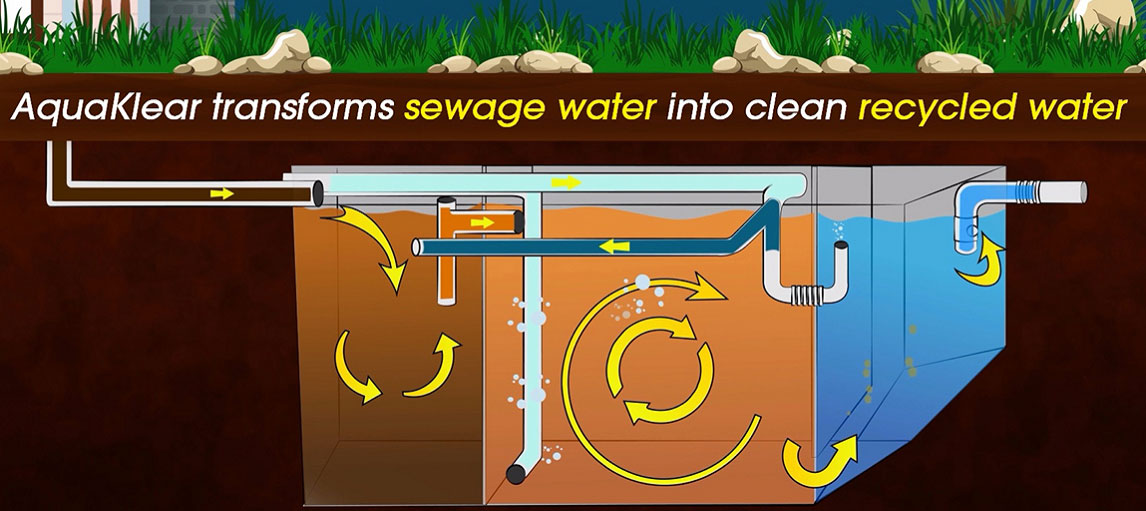FOR HOME OWNERS
Renew Your Service AgreementState of New Jersey Regulatory Requirements and Care and Usage Guide:

Original Graphic Courtesy of Better Than Septic, AquaKlear’s distributor of California & Hawaii
State Requirements:
Your system is required by New Jersey Department of Environmental Protection (NJDEP) regulations to have a valid yearly service contract for the life of the system from a manufacturer trained and authorized AquaKlear service provider; NJAC 7:9A-12.3(a) and (b). Per NJDEP regulations, the first two years service is included free upon installation. AquaKlear of New Jersey then bills you at $300.00 per year after the two year free service. This required service includes:
• Two annual visits. (Manufacturer Required)
• Issuing service reports to your local health department. (State Required)
• Check and record sludge levels to advise you when to pump your system. (State Required)
• Sample and record clarity of effluent. (State Required)
• Check and adjust skimmer if needed. (Manufacturer Required)
• Check air compressor for proper operation. (State Required)
• Notify NJDEP of annual service records (State Required)
The service contract signed during installation will be valid for all real estate transfers for the life of the system provided service fees are current. Failure to keep the service contract current will result in void of contract, notification to the local health department, notification to the NJDEP during the annual report, void of warranty and suspension of service.
Care and Usage:
Your AquaKlear system is an advanced wastewater treatment system that has additional parts including a blower, air line, and control panel. During the first few weeks it is common for odors to develop around the system and its components during initial startup. Within a month, your system will establish its “biological ecosystem” and these odors will dissipate. Should you detect odors thereafter, contact your manufacturer local service provider.
While your manufacturer service provider will conduct inspections of the unit at the frequency required by both the NJDEP and the manufacturer, these are some things you can do to avoid malfunction, system failure and costly repairs “ouch!”.
1. Pump the trash tank portion of your system when recommended by your service provider.

As with all septic systems, periodic pumping of solids is required to keep your system in top working order and ensure proper treatment of the wastewater entering the system. Your habits and household usage of the system will determine how often your system needs to be cleaned and pumped of solids. The system’s trash tank as shown on the diagram will develop a natural scum layer at the surface of the wastewater and a sludge layer at the bottom of the tank. This scum and sludge layer will continue to grow over time. It is recommended you have your system pumped and cleaned when the scum and sludge layers in your trash tank exceed 25% to 30% of the total capacity (424 gallon trash tank total capacity). Failure to adhere to the guidance can result in too much buildup of solids which can then “pass” into the aeration tank and clarifier causing the added expense of having those areas pumped too.
2. Frequent use of a garbage disposal can significantly increase the accumulation of sludge and scum in your trash tank resulting in the need for more frequent pumping to remove the solids. Eliminating the use of a garbage disposal will reduce the amount of solids and most importantly, fats, oil and grease, also known as FOG, from entering your system.
3. Do not put backflush from a water softener into your system. The brine can harm and destroy the natural bacteria.
4. Avoid strong disinfectant or bleaches other than those amounts normally used in laundry and house cleaning.
5. Avoid chemical wastes such as caustic drain openers, petroleum products, pesticides, paint or liquid fabric softener.
6. Do not flush disposable diapers, feminine hygiene products, cigarette butts, baby wipes, cat litter, coffee grounds or similar items that can clog or damage the system.
7. Notify your manufacturer service provider in the event a medical condition develops and strong antibiotics or other pharmaceuticals will be utilized for an extended period of time that might harm the natural bacteria in the system.
